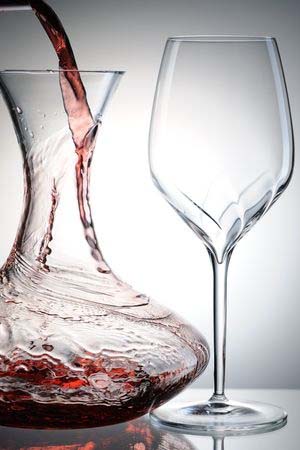Have you ever wanted a glass of red wine, but you didn’t plan ahead. If you’re wondering how long should red wine breathe, you’ve come to the right place. You usually allow it to breathe so that the oxygen can tone down the tannins and allow the flavors to mingle with them. Tannins as well as alcohol is what causes that sting in the back of your throat. When the wine doesn’t sting the back of your throat, or it does, but much less prior to allowing it to breathe, your wine is ready to drink. I call that sting in the back of the throat, a “bite”. When it has a bite, it needs a little more aging or breathing. Well, rather than waiting 30 minutes to several hours for a wine to breathe before you can enjoy it, there are some things you can do to speed up the process.

At Home
If the wine is less than 5 years old or tannic, and you’re at home, definitely allow it to breathe. My favorite way of speeding up the breathing process is the decanting method. You pour it out of its decanteer into a pitcher and back into the decanter a total of about 8 times. That’s 8 times being poured into the decanter and 8 times into the pitcher. You can do the same thing with a single glass of wine. Pour it into a bowl and then another bowl, back and forth.
If your wine has sediment at the bottom, leave about an inch of wine in the bottle.
If you’re physically not up to pouring the wine from pitcher to pitcher, consider using your blender and whipping it up until it tastes suitable. This method works, but is not as good as pouring it from container to container.
Away From Home
My favorite thing to do at a restaurant when we’re out with friends is to order champagne to drink while everyone is deciding on what to order. When we order the champagne, we also the order a bottle of red wine. This way, they can open it an allow it to breathe. Depending upon your server’s experience, you may need to ask them to do this.
[showmyads]
If the wine hasn’t had much time to breathe, or not at all, hold either by the stem, while it is still on the table, or hold down the bottom/foot of the glass by placing the stem between your forefinger and middle finger. Swirl the wine around a little, without lifting the glass. This is also the first step in tasting wine. More on tasting in a future post.
Which Wines Need to Breathe?
Wines heavier in tannins, and when young, need to breathe longer, several hours. Cabernet Sauvignon and Syrah are among them. A nice Merlot may not need much breathing. White wines as well as red wines will benefit from 30 minutes of breathing.
Is Wine Gluten-Free?
Yes. Wine is gluten-free, as it is made from grapes. However, when aged, the lids of wine barrels are sometimes sealed with wheat paste. However, if the bottle is labelled gluten-free, rest assured that it wheat paste was not used.
The barrels are pressure washed between uses. Whether the wines are hydrolyzed or not, the level of gluten in the wine is less than we can test for, under 5 parts per million (ppm), per Tricia Thompson, RD. She tested a couple of wines that spent the longest amount of time in wheat paste sealed oak barrels.
Stay Tuned In To Learn More
Next week my husband and I will be going wine tasting. We’re just learning about wine. I’ll fill you in on anything else I learn and perhaps the method of tasting. Clink!




